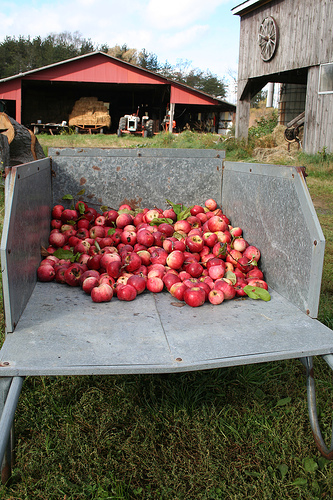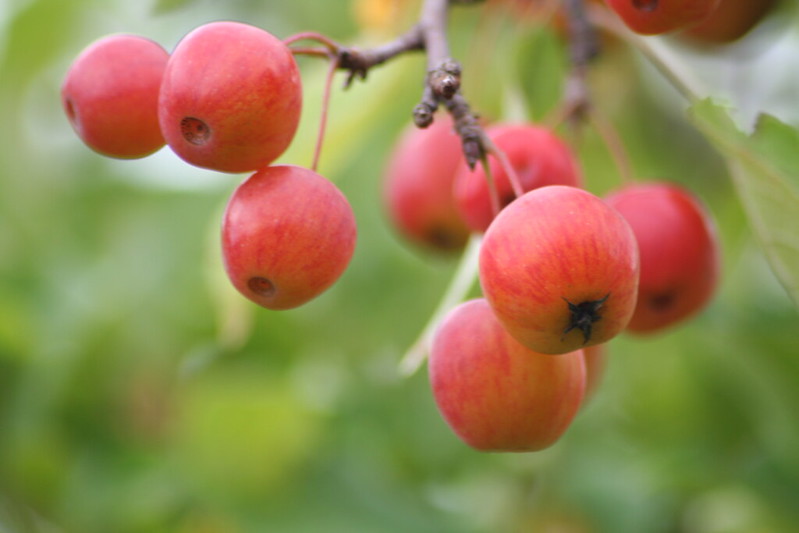Wandering around, fruitlessly looking for elderberries that the birds had missed (I don’t really know what I was thinking other than I wanted an excuse to take a walk…), we started surveying the apple trees. There weren’t, of course, any elderberries. Many of the trees had no apples, some had some. The bear had broken a couple, only to discover that the apples he brought down upon his head weren’t yet ripe, and so left them for the deer.
These aren’t domesticated varieties of apples, these are the wild ones, the ones who pulled their genetics from the nooks and crannies of their ancestors to present a fruit different from parents, siblings, and neighbors. We find them in the fields, in the hedgerows, in the little copses that have grown up over the years. We set them free, trimming around them to give them space, and wait to see what they will offer in return.

Most of the apples are mediocre. Some of them are terrible, take-a-bite-and-immediately-spit-it-out-like-a-disgruntled-toddler terrible, making a similar face while flinging the rest of the apple into the brush. A few of them are pretty good, and have earned themselves names – based on location, circumstance, flavor, or other trait. We have a pair called the Juice Trees, Upper and Lower. Taste is almost nothing, but wow are they juicy! Those trees often provide the base for the juice we press. One is so sour it surpasses any sour candy I’ve ever eaten and gives lemons a run for their reputation. It’s called Sour Tree. Others are Grouse Tree, Broken Tree, Triple Crown, and First Impression.
The last couple years we have worked to free a lot of the trees in the “Pricker Patch,” which is mostly blackberries (about which we also compete with the bear). All of the trees in this section start with “p” – Penelope, Paul, Peter, Pauline, Pricilla, and so forth. I will run out of names before I run out of trees, there are so many.
On this walk, there was a little tree at the top of Pricker Patch, below the elderberries. At the top there were 4 stunning orbs, bright red on one side blushing yellow to white on the other. They shone like a cardinal on a sunny winter’s day. Speckled with tiny spots… “Are those ripe?” A quick shake of the tree and one plunked to the ground. It is weedy enough underneath that no bruises appeared. I picked it up and admired it, but, knew better than to get my hopes up. Some of the most gorgeous apples on the property are absolutely foul-tasting. A quick rub on my shirt and I bit into it. Crisp. Juicy. Tart and tangy with a balance of sweetness so you don’t quite know what you’re tasting. He reached for it and my response was something along the lines of “No, this one is mine” although it could have been closer to a growl. We did pick the others so they wouldn’t tempt the bear. And that is the first wild apple I’ve eaten all of in a very long time.
Time managed to eventually combine qualities and traits until he landed on the perfect apple combination. And so that’s the tree’s name, Perfection. Nature is astonishing in its variety, and apples demonstrate it well. Any apple seed will grow into a tree that produces different fruit than its parents. With the birds, bears, raccoons, turkeys, foxes, squirrels, and deer all sampling apples and moving the seeds about, I have no idea the parents of Perfection.
And isn’t that the story of living a life close to the land? The origins are known, yet still mysterious; the processes understood but not fully. What is an apple? It is a fruit, a seed covering, a meal, an inspiration. It is the raw material for pie, sauce, jelly, cider, and wine. It is the vitamin C from the root cellar in the depths of winter. It is temptation, oasis, salvation. It is the future, whether foul or perfect, in all its infinite combinations.
In a season, in this year-of-all-years more so, of never-ending things to do and grow and learn, a walk for elderberries turned into a delicious discovery. Is there more to find? Always. A walk is never just a walk. Even you what you find isn’t what you wanted to find, sometimes it might be better.
You can walk Audubon’s trails anytime dawn until dusk, and the season is excellent. There are even some wild apple trees to taste-test, though the Day Campers know the best tree and have picked it clean. There is also a program on how to tell if your apples are actually ripe on September 22. (Honestly some of the foul tasting apples might not have been ripe… I’ll have to try them again). There is a lot of discover out there, regardless of your intention.
Audubon Community Nature Center builds and nurtures connections between people and nature. ACNC is located just east of Route 62 between Warren and Jamestown. The trails are still open from dawn to dusk as is Liberty, the Bald Eagle. The Nature Center will partially reopen on September 5 including restrooms and the Blue Heron Gift Shop and some exhibits. More information can be found online at auduboncnc.org or by calling (716) 569-2345.


Recent Comments